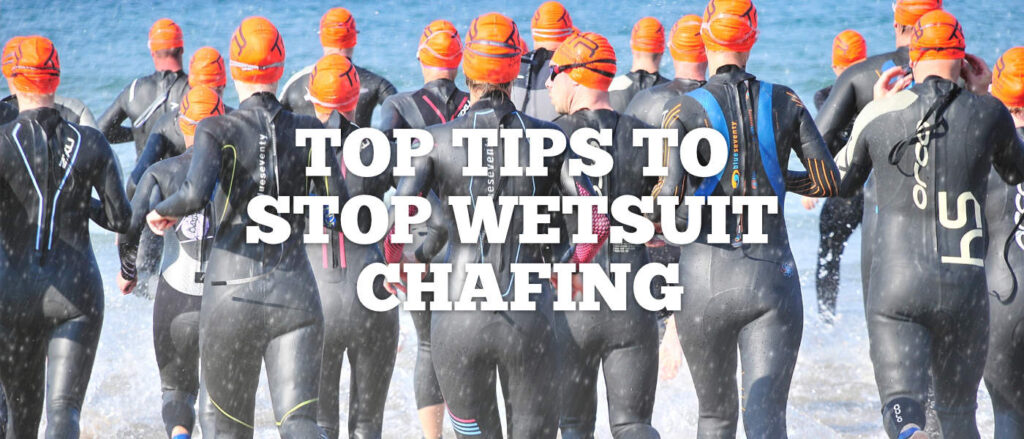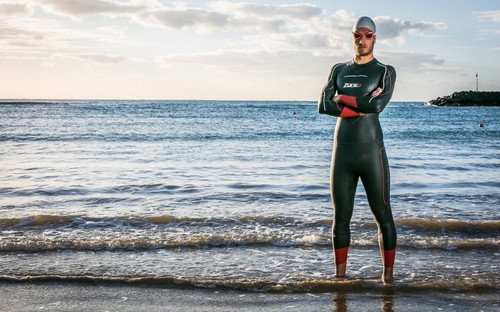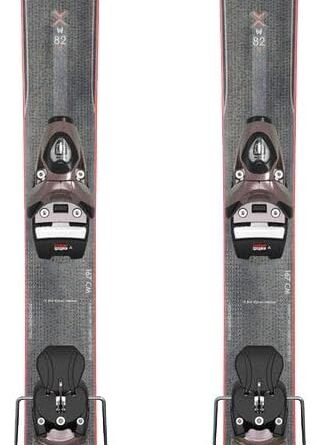
If you’re planning to hit the waves and spend some quality time in the water, there’s one annoying thing that can put a damper on your aquatic adventures: chafing. When it comes to wearing a wetsuit, chafing can be a real nuisance. But fear not, we’ve got you covered! In this article, you’ll find some helpful tips on how to prevent chafing and ensure a comfortable and enjoyable wetsuit experience. So, grab your wetsuit and let’s dive into the world of chafe-free surfing!

This image is property of triathlonbudgeting.com.
Choose the Right Size and Fit
Measure Yourself Properly
When it comes to preventing chafing while wearing a wetsuit, selecting the right size and fit is crucial. The first step is to measure yourself properly. Use a tape measure to determine various body measurements such as chest, waist, hips, and inseam. Make sure to refer to the wetsuit manufacturer’s size chart to choose the appropriate size based on your measurements. Remember, a wetsuit that is too tight can cause discomfort and chafing, while a loose-fitting wetsuit may rub against your skin and lead to irritation.
Consider the Material and Stretch
Another important factor to consider when choosing a wetsuit is the material and stretch it offers. Look for wetsuits made from high-quality neoprene that provide sufficient flexibility and stretch to accommodate your movements. A wetsuit with good stretch will minimize friction against your skin and reduce the likelihood of chafing. Additionally, consider the thickness of the wetsuit for the specific water conditions you’ll be in. Thinner suits may provide more flexibility but may also be more prone to chafing.
Try Different Brands and Styles
Every brand and style of wetsuit fits differently, so it’s worth trying out various options to find the one that suits you best. Even if you have a preferred brand, it’s still worthwhile to explore what other brands have to offer. Different brands may have slightly different sizing or construction techniques that could make a difference in terms of chafing prevention. Additionally, try on different styles, such as full suits, shorties, or spring suits, to see which design works best for your body type and offers the most comfort.
Apply Lubrication
Use a Specialized Wetsuit Lubricant
To further reduce the risk of chafing, applying a specialized wetsuit lubricant before putting on your wetsuit can be incredibly helpful. These lubricants are specifically designed to provide a smooth surface between your skin and the wetsuit, minimizing friction and irritation. Look for lubricants that are water-based and non-greasy, as they will not degrade the neoprene material of your wetsuit.
Apply Lubricant on Chafing-Prone Areas
Focus on applying the lubricant on areas of your body that are prone to chafing, such as the neck, underarms, and inner thighs. These areas often experience the most friction when wearing a wetsuit, so providing extra protection will help reduce irritation. Don’t forget to apply the lubricant liberally, ensuring that you create a thin, even layer on your skin.
Reapply as Needed
Remember to reapply the lubricant as needed during prolonged use. Although wetsuit lubricants are long-lasting, they may gradually wear off due to movement and water exposure. If you start to feel any discomfort or notice increased friction, take a break and reapply the lubricant to maintain a smooth and comfortable wetsuit experience.
Wear a Rash Guard or Base Layer
Choose a Moisture-Wicking Fabric
One effective strategy to prevent chafing is to wear a rash guard or base layer underneath your wetsuit. Opt for garments made from moisture-wicking fabrics such as nylon or polyester. These materials are designed to pull moisture away from your skin, keeping you dry and reducing the likelihood of chafing. Avoid cotton fabrics, as they tend to retain moisture, leading to increased friction and discomfort.
Ensure a Snug Fit
When selecting a rash guard or base layer, ensure that it fits snugly against your skin without being too tight. A properly fitted garment will create a barrier between your skin and the wetsuit, reducing the chances of friction and chafing. Check for any seams or tags that could rub against your skin and cause irritation. Opt for seamless options to minimize potential sources of friction.
Consider Seamless Options
Seamless rash guards or base layers can be especially beneficial in preventing chafing. Without any seams to rub against your skin, the risk of irritation and discomfort is significantly reduced. Look for seamless garments that offer a seamless construction technique, providing a smooth and friction-free experience.
Reduce Friction with Neoprene Decking
Apply Neoprene Tape on Chafing Areas
Neoprene decking, also known as neoprene tape, can be an effective solution to reduce friction and chafing in specific areas. Apply neoprene tape to areas of your body that commonly experience rubbing against your wetsuit, such as the inner thighs, underarms, or neck. The neoprene material acts as a protective layer, reducing friction and preventing irritation.
Use Spray-on Lubricants with Neoprene Properties
In addition to neoprene decking, you can also use spray-on lubricants with neoprene properties for added protection against chafing. These lubricants create a thin layer on your skin and wetsuit, reducing friction and improving overall comfort. Look for spray-on lubricants specifically formulated for use with neoprene materials to ensure compatibility and effectiveness.

This image is property of www.bestoutdoors.co.uk.
Take Care of Your Wetsuit
Rinse and Dry Your Wetsuit Properly
Proper care and maintenance of your wetsuit can prolong its lifespan and help prevent chafing. After each use, rinse your wetsuit thoroughly with fresh water to remove any salt, sand, or chlorine. Make sure to turn the wetsuit inside out and rinse both the inside and outside. Hang your wetsuit to dry in a well-ventilated area away from direct sunlight. Avoid using a clothes dryer, as the excess heat can damage the neoprene and decrease its elasticity.
Avoid Excessive Sun Exposure
While it’s important to dry your wetsuit, it’s equally crucial to avoid excessive sun exposure. Prolonged exposure to direct sunlight can weaken the neoprene material over time, making it more prone to chafing and other forms of damage. When drying your wetsuit, choose a shaded area or use a wetsuit hanger with UV protection to minimize sun exposure.
Store Your Wetsuit Correctly
Proper storage is key to keeping your wetsuit in great condition and reducing the risk of chafing. After your wetsuit has dried, fold it neatly or use a wetsuit hanger to hang it in a cool, dry place. Avoid storing your wetsuit in a compressed position for an extended period, as this can cause creases and weaken the neoprene. Additionally, make sure to keep your wetsuit away from sharp objects or abrasive surfaces that could damage the material.
Protect Your Skin with Body Glide or Petroleum Jelly
Apply Before Putting on the Wetsuit
For additional chafing prevention, consider applying a protective layer of body glide or petroleum jelly on your skin before putting on the wetsuit. These products create a barrier between your skin and the wetsuit, reducing friction and minimizing irritation. Apply a thin layer to areas prone to chafing, such as the neck, underarms, or inner thighs.
Focus on Chafing Hotspots
Pay special attention to chafing hotspots when applying body glide or petroleum jelly. These areas are more susceptible to irritation due to increased friction. By focusing on these spots, you can provide targeted protection and significantly reduce the risk of chafing. Don’t forget to reapply the product if you notice any discomfort during use.
Reapply during Prolonged Use
During prolonged use or activities that involve continuous water exposure, such as surfing or diving, consider reapplying body glide or petroleum jelly periodically. Water can wash away the product, diminishing its effectiveness over time. By reapplying as needed, you can maintain a smooth and comfortable experience throughout your wetsuit use.

This image is property of cdn.triathlete.com.
Consider Anti-Chafing Products
Use Anti-Chafing Balms or Creams
There are various anti-chafing balms or creams available in the market specifically designed to prevent chafing. These products often contain moisturizing ingredients that soothe and protect the skin, reducing friction and irritation. Apply the balm or cream to areas prone to chafing before putting on your wetsuit for added protection. Look for products that are long-lasting and suitable for use with wetsuits.
Try Silicone-Based Chafing Ointments
Another option to consider is silicone-based chafing ointments. These ointments create a protective barrier on your skin, reducing friction and preventing chafing. Silicone has a smooth and slippery texture that helps minimize irritation caused by wetsuit movement. Apply the silicone-based ointment to chafing-prone areas before wearing your wetsuit to ensure maximum comfort and protection.
Pay Attention to Seam Construction
Choose Flatlock Seams
Seam construction plays a significant role in chafing prevention. When selecting a wetsuit, look for those with flatlock seams. Flatlock seams lie flat against your skin, reducing the likelihood of rubbing and irritation. They are also less bulky and provide a more comfortable fit overall. However, it’s important to note that flatlock seams are not as watertight as other types of seams, so they may not be suitable for extremely cold water conditions.
Opt for Glued and Blind Stitched Seams
For enhanced durability and improved watertightness, consider wetsuits with glued and blind stitched seams. These seams are first glued together, preventing water penetration, and then stitched with a blind stitch that minimizes the chances of rubbing against your skin. Glued and blind stitched seams provide a smooth finish, reducing friction and ensuring a more comfortable experience.
Avoid Overlapping Seams
When trying on wetsuits, pay attention to any overlapping seams that may cause discomfort or chafing. Overlapping seams can create additional layers of neoprene that increase friction and irritation. Opt for wetsuits with minimal overlapping seams, especially in areas prone to chafing, to maintain optimal comfort and reduce the risk of skin irritation.

This image is property of cdn-0.surfersfootprint.com.
Wear Proper Undergarments
Avoid Cotton Undergarments
The type of undergarments you wear underneath your wetsuit can greatly impact your comfort level and chafing prevention. Avoid wearing cotton undergarments, as they retain moisture and become heavy when wet. Moisture retention can lead to increased friction, making your skin more susceptible to chafing. Instead, opt for undergarments made from moisture-wicking fabrics that keep you dry and comfortable throughout your wetsuit use.
Choose Moisture-Wicking Fabrics
Similar to choosing a rash guard or base layer, select undergarments made from moisture-wicking fabrics such as nylon or polyester. These materials pull moisture away from your skin, minimizing friction and reducing the likelihood of chafing. Look for undergarments that have a snug fit without being overly tight, ensuring a comfortable and irritation-free experience.
Opt for Seamless Construction
Undergarments with seamless construction can provide an extra layer of chafing protection. Seamless designs eliminate potential sources of friction, creating a smoother surface against your skin. Look for undergarments that have a seamless construction to minimize irritation and enhance overall comfort while wearing a wetsuit.
Gradually Increase Wetsuit Usage Time
Build Up Tolerance to Chafing
If you’re new to wearing a wetsuit or haven’t worn one in a while, it’s important to gradually increase your usage time to build up tolerance to chafing. Start with shorter sessions to allow your skin to adapt to the wetsuit’s material and reduce the risk of chafing. As your skin becomes accustomed to the wetsuit, gradually increase the duration of your sessions while monitoring for any signs of discomfort or irritation.
Take Breaks and Allow Your Skin to Breathe
During prolonged use, it’s essential to take regular breaks and allow your skin to breathe. Extended periods of wearing a wetsuit can create a humid environment that promotes moisture retention, increasing the risk of chafing. Take short breaks between activities or sessions to remove the wetsuit briefly and allow your skin to dry and breathe. This will help reduce moisture buildup and prevent potential chafing.
Don’t Overdo Your Wetsuit Use
While it may be tempting to spend long hours in the water wearing your wetsuit, it’s important not to overdo it. Excessive and prolonged use of a wetsuit can increase the chances of chafing and skin irritation. Listen to your body and give it sufficient rest between sessions to recover and reduce the risk of discomfort. Remember, it’s better to enjoy your time in the water comfortably rather than pushing yourself too hard and experiencing the negative effects of chafing.
By following these tips and implementing the necessary precautions, you can significantly reduce the risk of chafing while wearing a wetsuit. Remember, prevention is key, so invest time in choosing the right size and fit, apply lubrication when necessary, wear suitable undergarments, and take care of your wetsuit properly. With these measures in place, you can enjoy your water activities comfortably and chafe-free.

This image is property of cdn11.bigcommerce.com.






